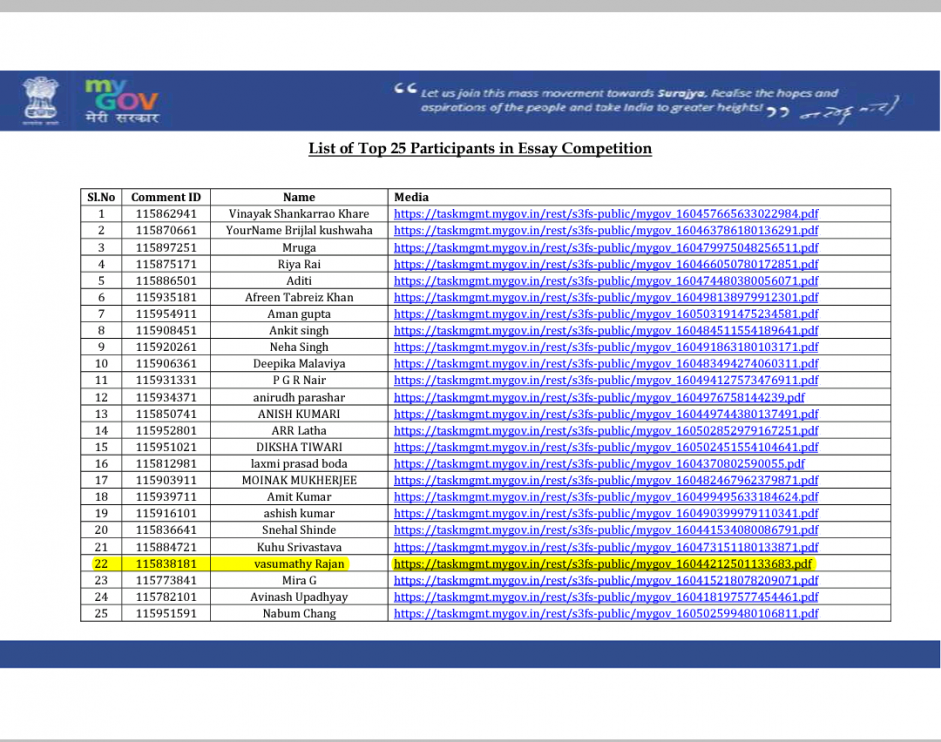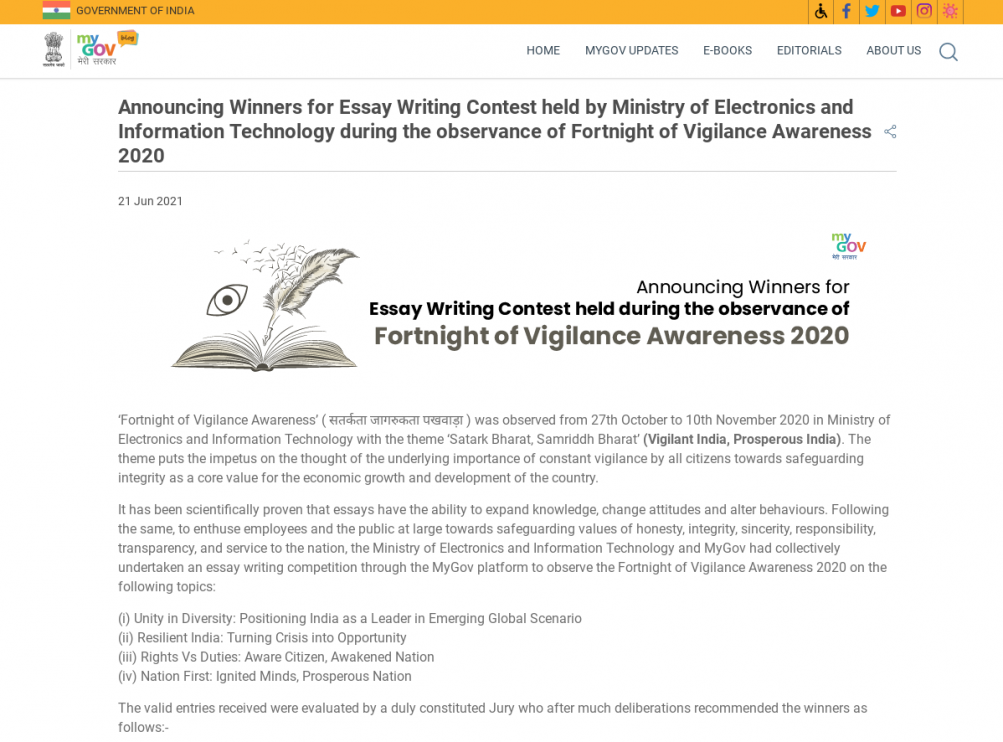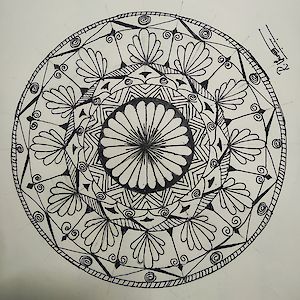- click here to go the Link to results announcement page in mygov.in
- click here to Read the top 25 essays (22nd is mine)
- click here to go the Link hosted in mygov.in
Vigilant India, Prosperous India
“In a democracy, the well -being, individuality and happiness of every citizen is important for the
overall prosperity, peace and Happiness of the nation”
-Dr.A.P.J. Abdul Kalam
The prosperity of a country depends, not on the abundance of its revenues, nor on the strength of
its fortifications, nor on the beauty of its public buildings; but it consists in the number of its
cultivated citizens, in its men of education, enlightenment and character.
-Martin Luther
Prosperity of a nation:
Most economists traditionally use a simple economic measure known as GDP to define prosperity of a nation. But, prosperity is more than just the accumulation of material wealth. Prosperity also entails personal and social wellbeing of the citizens. As per Legatum Institute, there are certain conditions which needs to be considered when calculating prosperity index of a country.These conditions are a combination of nine pillars: Economic Quality, Business Environment, Governance,Personal Freedom, Social Capital, Safety and Security, Education, Health, and the Natural Environment.Each one of these nine pillars can be disturbed or diminished with corruption.
Corruption and Prosperity:
An increase in corruption in any society will always affect prosperity of that society. As per Transparency International, Denmark is found to be the least corrupt country and as per Legatum Institute Denmark is also the most prosperous country in the world. This gives us a clear understanding how corruption and prosperity are negatively correlated. India ranks 80th cleanest country as per Transparency International’s 2019 ranking list and stands at 101st in the global prosperity index 2019 as released by Legatum Institute.When you compare with Denmark India is rich in natural and human resources. Still we are far behind them in prosperity index. This is due to the corruption that is still rampant in our system.
Corruption in India:
Governmental / Administrative corruption:
Aristotle, the third-century Greek philosopher, defined corruption as the practice of leaders who rule with a view to their private advantage rather than the pursuit of the public interest. Recently it is defined as behaviour by government officials that violates publicly sanctioned moral standards. In the early twenty-first century, the definition most commonly used among social scientists is the abuse of public office for personal enrichment. Such abuse occurs in many forms. The most common include bribery, extortion, embezzlement of government resources, violation of campaign laws, and electoral fraud.
Professional corruption:
When a person is involved in unfair business practices then it comes under professional corruption. A person of certain profession does not perform his/her duty well or not allowed to perform his/her duty can be regarded as professional corruption.
Corruption in health sector:
In 2013, Raigad-based physician filed a complaint with medical council with irrefutable documentary evidence that a diagnostic centre had offered him a “cut” or kickback to refer his patients to them. This is a classic example of corruption in health care industry. Average market price of paracetamol 500mg is Rs.15(approx.) while that of generic medicine of
paracetamol 500mg is Rs.3 (approx.). A branded medicine of even a simple paracetamol costs 5 times more than that of generic medicine. Not all doctors but a few of them are always there who don’t prescribe generic medicine but branded medicine of the companies which provide kickbacks. This is another example of corruption in health sector.
Corruption in Agriculture sector:
India is the fourth largest food producer in the world. Ironically, we are also the country facing farmer distress and unrest year after year. We produce enough to feed our 1.3 billion citizens but the economic re-distribution of this production is not transparent. When we shell out Rs.100 per kg of onion the farmer gets only Rs.7-8 per Kg. This clearly shows that it’s the middle men who make huge profits. This is a classic example of corruption existing in agriculture sector.
Corruption in Banking Sector:
As per Reserve Bank data, as many as 5,200 officials of public sector banks were punished for fraud between January 1, 2015 and March 31, 2017. Bribes and kickbacks are taken to grant loans. Recent scams involving ICICI, PNB, PMC are examples of rampant corruption in Banking Sector.
Corruption in Indian legal system:
Corruption is also seen in Indian legal system. Starting from filing a case to the decision on the case corruption has its deep routes at every stage. The report of Transparency International’s Global Corruption Barometer 2013 says that 45 percent of surveyed households in India considered judiciary to be corrupt or extremely corrupt and 36 percent of households who had contact with the judiciary in 2012 reported to have paid a bribe.Bribery is common in the judicial system. Transparency International Report 2012 said that the most common reason for giving bribe in India in general is to speed things up.
Corruption in Education Sector:
Indian education system is mired in corruption and a high rate of teacher absenteeism was a key factor for it according to a global study. The UNESCO International Institute of Educational Planning study on corruption in education says that 25% teacher absenteeism in India is among the highest in the world while the global average of teacher absenteeism is about 20%.Private tutoring practice by teachers is identified by UNESCO as unethical. As per the report private tutoring does not complement learning at school and it leads to corruption. The practice of ghost teachers and involvement of teachers in mismanagement of schools were other grey areas identified as corruption practices in the Indian education system.
Corruption is seen in each and every sector of the country. So curbing corruption is very much essential to attain prosperity. But How?
Several anti-corruption laws were framed in our country to curb corruption. They are:
- Indian Penal Code, 1860
- Prosecution section of Income Tax Act, 1961
- The Prevention of Corruption Act,
- The Benami Transactions (Prohibition) Act, 1988 to prohibit benami transactions.
- Prevention of Money Laundering Act, 2002
- The Lokpal and Lokayuktas Act, 2013
- Whistle Blowers Protection Act, 2011
- Companies Act, 2013
Apart from these laws, Central Vigilance Commission (CVC) an apex Indian governmental body was created in 1964 to address governmental corruption and in 2003, the Parliament enacted a law conferring statutory status on the CVC i.e. the status of an autonomous body, free of control from any executive authority. It is charged with monitoring all vigilance activity under the Central Government of India, advising various authorities in central Government organizations in planning, executing, reviewing and reforming their vigilance work. Apart from CVC there are state vigilance commissions which can look into the vigilance work of state government organisations. But are all these laws and commissions enough to curb corruption? Definitely this is not enough. In spite of having all these laws and commissions corruption in rampant in our country. So, what is required is individual vigilance. Every citizen of our country must stay vigilant.
Vigilance, is defined as action or state of keeping careful watch for possible danger or difficulties. Vigilance takes several forms- preventive, detective and punitive vigilance. Preventive
vigilance is aimed at reducing the occurrence of a lapse (violation of a law, a norm, or, broadly speaking, a governance requirement). Detective vigilance is aimed at identifying and verifying the occurrence of a lapse. Punitive vigilance is aimed at deterring the occurrence of a lapse. People always have wrong approach towards vigilance as they perceive vigilance as enquiry, fixing responsibility etc. Vigilance is not investigation but it is prevention. Preventive Vigilance forms the first stage, much ahead of the other forms of vigilance. Only when preventive vigilance fails does the question of detective/investigative and punitive vigilance arise. The well-known doctrine ‘Prevention is better than cure’ applies to domestic as also international situations equally. As we lock our houses and take our insurance policies to guard against possibilities of theft and burglary, many preventive steps can be taken to reduce chances of corruption. To punish and not to prevent is like pumping the water through a pump without arresting the leakages which would result in wastage of water, energy and time.
Aspects / Tools of Preventive Vigilance in establishments :
1. Standardization of conditions and procedures so that they are clear and same for everyone.
2. Usage of computerized system to reduce the interference of officials and to ensure transparency.
3. Transparency in official functions and legalities should be there so that there is no matter or issue which the public does not know about.
4. The system should hold the officials accountable. They are responsible for their action or inaction. For every improper activity, penalty should be there.
5. Effective control and supervision is required. Without effective control on subordinates,corruption free system is not possible.
6. Employees should be provided a healthy work environment which should be free of any unhealthy competition and illegal dealings.
Preventive vigilance is not only to be followed by employees of the organisation. But every citizen of our country needs to be vigilant. If ever any government employee asks for a bribe learn to say no to the demand. Just to avoid delay or hassle don't comply to their demands. If ever you see a person asking or giving bribe or being corrupt inform appropriate vigilance authorities so that the corruption can be nipped in the bud. If each and every one of us turn vigilant, then India can become corruption free down the lane. Once corruption is curbed automatically India can become prosperous.
As our Prime Minister said " Our vision of development is human-centric, one where the fruits of prosperity reach everyone in an equitable manner. This can be realised only when 130 crore Indians remain aware and vigilant and perform their duties and responsibilities as proud citizens” .The following quote of Dr.A.P.J. Abdul Kalam is something which is very important in building a corruption free nation and for the younger generation to be vigilant against corruption. "If a country is to be corruption free and become a nation of beautiful minds,I strongly feel there are three key societal members who can make a difference.They are the father, the mother and the teacher".When our citizens turn vigilant, India can achieve Prosperity and development both economically and socially.
"We will be remembered only if we give to our younger generation a prosperous and safe India,resulting out of economic prosperity coupled with civilisational heritage."
-Dr. A.P.J Abdul Kalam
Last but not least Albert Einstein once said, "World will not be destroyed by those who do evil but by those who do nothing to stop them". So, be vigilant, make our country prosper.
"Vigilant India , Prosperous India"
Jai Hind









